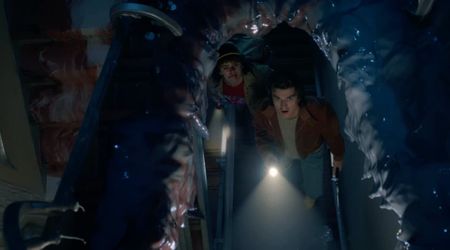'Constellation' Episode 4: Meaning of the Interference Effect explained

STOCKHOLM, SWEDEN: Apple TV+'s psychological thriller series 'Constellation' introduces us to a concept of Quantum physics called the Interference effect.
As per Tech Target, it is a phenomenon when "subatomic particles interact with and influence themselves and other particles while in a probabilistic superposition state."
In the third episode of 'Constellation', Henry Caldera (Jonathan Banks) is seen explaining the meaning of Quantum Physics to Alice Taylor (Davina Coleman and Rosie Coleman).
Using a thought experiment, he prompts her to visualize a particle existing in two different states simultaneously—one world portraying it as black, the other as white.
Henry goes on to challenge her to envision this particle existing in a liminal space between these worlds, where it can embody both black and white but only determine its state when observed. This loosely explains the theory of the Interference effect in Apple TV's 'Constellation'.
Scientific American defines it as "A wavelike interaction between particles related to the weird quantum phenomenon of entanglement—occurring between two different kinds of particles."
"When entangled, the quantum states of multiple particles are linked so that measurements of one will correlate with measurements of the others, even if one is on Jupiter and another is on your front lawn," it further explains.
How does Henry Caldera's CAL experiment relate to the Interference effect?

The theory of quantum superposition challenges classical physics by asserting that a particle can exist in multiple states simultaneously.
However, when observed or measured, the particles collapse into a specific state, adhering to classical physics principles—a phenomenon known as the observer's effect, illustrated through the double-slit experiment.
Henry's CAL experiment is meant to demonstrate the Interference effect by capturing a state in which one particular is in two different states simultaneously.
Why only Henry Caldera and Jo Ericsson can see the Interference effect?

In the fourth episode, Henry attempts to explain his CAL experiment to an MIT professor. Unfortunately, the observer's effect prevents him from recording or measuring evidence. Henry speculates that the experiment alters the observer's perception, challenging conventional quantum physics understanding.
Up to now, only Henry and Jo have been able to witness the Interference effect. This is likely due to their exposure to Henry's CAL experiment, placing them in a liminal reality where their alternate states converge into one.
The characters in Constellation, exist in multiple states, much like particles in quantum superposition. This implies that some astronauts have landed in a liminal space between alternate worlds.
These astronauts, experiencing dual states, attributed their visions to the traumatic impact of space travel, unaware of their interchange between alternate selves.
This also explains peculiar occurrences in Jo Ericsson's (Noomi Rapace) life, where in one reality, she is back on Earth while Paul is dead, and in a parallel reality, Alice witnesses Jo's funeral while Paul is alive.
A new episode of 'Constellation' drops on Apple TV+ every Wednesday.










